Comprehensive Assessment of Triggers for Behaviours of Concern Scale (CATS): Initial Development
Abstract
1. Introduction
2. Materials and Methods
2.1. Stage 1
2.2. Stage 2
3. Results
3.1. Generating Contextual Triggers Item Pool and Categorising Items
3.2. Stakeholder Feedback on CATS
4. Discussion
4.1. CATS and Other Contextual Assessments
4.2. Associations of Item to Challenging Behaviour
4.3. CATS and the Environment
4.4. Strengths
4.5. Weakness
5. Conclusions
Author Contributions
Funding
Institutional Review Board Statement
Informed Consent Statement
Data Availability Statement
Conflicts of Interest
Appendix A
| Behaviour (B) | A list and clear description of the target behaviour(s) to be addressed. |
| The type and the nature of the behaviour(s). | |
| Past history of similar behaviour. | |
| Baseline behaviour prior to the onset of current problem behaviour. | |
| The onset of the behaviour(s) to describe whether they appeared gradually over time or relatively abruptly perhaps precipitated by an acute event. | |
| The frequency, severity, and duration of the behaviour(s). | |
| Reactions to the behaviour by the person/ others/ services. | |
| Associated behaviours (other relevant behaviour than the target behaviours). | |
| The impact of the behaviour(s) on the person’s life, other’s life, and the environment. | |
| Consequences of problem behaviour e.g., reduced quality of life for the individual and her/his caregivers; reduced access to services including education, day service, and employment opportunity and may lead to a threatened or actual loss of placement in a residential setting or day placement; reduced social activities including leisure activities, access to friends, etc.; physically restraint; medicated; in severe cases, hospitalised or prosecuted. | |
| Assessment of risks of behaviour e.g., risk to others; risk to the individual; risk to the environment and other risks. | |
| Previous risk assessment. | |
| Review of previous and current measures taken to reduce risks to assess their effectiveness. | |
| The function of the behaviour (what does the behaviour want to achieve?). | |
| Medical and Organic Factors (M) | Physical symptoms (toothache, tummy ache, heartburn, headache etc.). |
| Acute or chronic physical /medical conditions (cardiovascular, respiratory, endocrine, gastrointestinal, musculoskeletal, dental, skin and genito-urinary). | |
| Physical disabilities. | |
| Problem with sleep, appetite, weight, bowel, bladder. | |
| Epilepsy, and other neurological conditions (spasticity, movement disorders, multiple sclerosis, brain tumour etc.). | |
| Genetic conditions (Lesch-Nyhan syndrome, Prader-Willi syndrome, Fragile X syndrome, Smith-Magenis syndrome etc.). | |
| Sensory impairment. | |
| Communication/speech problems. | |
| Drug and alcohol related factors. | |
| Current medication, previous medication, polypharmacy and high dose medication use, adverse effects including anticholinergic burden. | |
| Relevant histories (Person) | Family, occupational, relationship. |
| Current accommodation, daytime occupation, leisure activities, family circumstances. | |
| Patient’s interests, strengths-abilities, likes, dislikes and preferences and how they express these opportunities, impact of disabilities, needs (including mental and physical health), and service and resource gaps. | |
| Their history-social, developmental, psychological and history of use of services. | |
| Difficulties in developing fulfilling relationships. | |
| Daily/ weekly diary. | |
| Psychological/ Psychiatric Factors (P) | Psychiatric Disorders: Psychoses, Bipolar disorders, dementia, Depressive disorders, and anxiety related disorders etc. |
| Psychological/ emotional issues (such as bereavement, recurrent stress and relationship difficulties leading to loss of self-esteem and isolation, abuse, etc.). New/ ongoing/ recurrent stress. Difficulty in developing fulfilling relationships. Developmental disorders, like Autism Spectrum Disorder (ASD) and Attention Deficit Hyperactivity Disorder (ADHD), including impulsivity, Neuropsychological factors. | |
| Relevant history of psychological development. | |
| Psychological symptoms: depression, anxiety etc. | |
| Personality traits. | |
| Dysregulated arousal and affect. | |
| Social/environmental Factors (S) | Crowded/noisy/uncomfortable environment. |
| Demanding activities, lack of interesting activities, too many changes in the activities etc. | |
| Personalities of other people/ staff and interactions with other people. | |
| Change in the environment, activities of daily living at home (e.g., washing, cleaning), activities of daily living outside home (e.g., shopping), relationships, influence of life events, occupation and activities including leisure activities and financial situation, therapeutic interventions. | |
| Under- or over-stimulating environment. | |
| Issues relating to integration within the wider society, stigmatisation and discrimination. | |
| Carer issues, including levels of stress and lack of support for carers. | |
| Changes required in the level of supervision and support, major life events including abuse. | |
| Adequate support for patients and also their caregivers (both family caregivers and paid care staff). |
Appendix B
| Theme/ Subtheme | Illustrative Quotes |
|---|---|
| External Environment | |
| Physical environment | P does not like loud people, the noise will agitate him. People being noisy. P does not like noisy environments. Excessive noise. Loud, unexpected noises, sneezing, coughing. Loud noises will make P jump. P gets verbally aggressive and cross when there are loud, unexpected noises [for example], fireworks. Things on TV, favourite shows like Casualty and Holby City: gruesome things and seeing blood on TV. Violent videos, P would watch them over and over again and get wound up and aggressive himself. P would be aggressive when asked to turn them off. Busyness around the home. P lives in a large group home, and it is generally quite busy and noisy; P does not tolerate this very well. Staff changeover: this is because it is a busy time in the house with lots of noise. P does not like crowds or being in groups. P does not like being in busy places, large shopping centres. He will start pacing and shouting as he becomes more distressed in his surroundings. People invading her personal space—P will tend to lash out. P does not like being touched. P does not like too much sensory input and can become overloaded which leads to anxiety and agitation. |
| Social environment | P will act out to become the centre of attention. P will physically attack other residents to become the centre of attention. P will have temper tantrums to seek company and attention. This is a learnt behaviour as P knows it will get her what she wants—attention from someone. Seems P is always looking for a reaction, for example, his banging will escalate more and more until he has been told to stop it. P likes to get a reaction. To provoke negative reactions in other people, especially other service users. This is part of P exerting his power and authority over people. Being ignored or observing others getting all the attention. Jealousy over other residents getting more attention from staff. Jealousy over other service users especially around staff attention, going out and family visits. P does not see her family very often and she can get jealous when other residents see their family and go to stay with them... this can lead to aggression. When relatives visit, approximately twice a year—exacerbates the problem as P gets excited. Family visits: P can become anxious when he knows his family are due to visit. Going to his parents; P’s last severe outburst was related to the build-up in agitation before he went home. Family contact—pre and post; P seems to get upset around family visits, could be because she feels rejected. Family rejection can be a key trigger; because of this, P can interpret a lot of things as rejection and this then triggers her aggressive behaviour. Conflicting with his father; they have physical fist fights and tend to wind each other up. Friction with another resident exacerbates the aggression. P is always verbally aggressive towards this other resident but will take out anger on the other residents as well. P clashes with another service user; the other person is very able and verbal as well. They fight over the ‘pecking order’ in the house but do sometimes get on. Two certain staff members—P will be very verbally aggressive when they are on shift. There have been frictions with certain members of staff and the way they supported P. People disagreeing with P—you are better off agreeing with some things. Being reminded he has done something wrong. Being caught out when he has done something wrong. When she is accused of lying. Criticism and being corrected. Other people’s behavioural problems [for example], screaming or anxiety-related behaviours. P does not like to sense other people’s anxiety as it upsets him. Verbal aggression—if other service users are shouting. P gets upset when he hears his parents arguing. |
| Internal Environment | |
| Aversive physical states | When P is hungry or thirsty. When poorly. When tired. When P gets too hot. Pain; most of P’s behaviour is related to pain. Pain, hence paracetamol prn [pro re nata/as needed] is often effective as a first line intervention. |
| Medical conditions | The menopause. PMT [pre-menstrual tension]. UTIs [urinary tract infections]. Hyper or hypo related to diabetes. Constipation and irritable bowel syndrome. Epilepsy. Leading up to a seizure. |
| Mental health problems | P’s mental health—P will be more irritable and more inclined to shout and slam doors when she is in a hypomanic phase. Paranoia is P’s key trigger; thinking others are talking/spying/staring or looking at him. P can be very violent when his paranoia is bad. Increase in schizophrenia symptoms leads to increase in aggression. When P is depressed, she will be more likely to self-injure. SIB related to depression. |
| Emotional states | Excitability can lead to an outburst as P gets mixed up with his emotions. P can get anxious when he gets really excited; the increasing emotion can get misinterpreted. The build up, anticipation and excitement of activities can lead to aggression. P will become anxious when waiting for an activity. Things that cause anxiety, then agitation, then they can cause aggression. Behaviour is anxiety related—all to do with this. Anxiety; all of P’s behaviours are anxiety related. This leads to frustration and then possibly aggression. P will act out when bored. P does not tolerate boredom—P can be aggressive when bored. Boredom—P needs to be kept busy and needs things to look forward to. Feeling he has made a fool of himself. P gets annoyed with himself if he thinks he has made a fool of himself, if someone bumps into him, he will say sorry and be cross with himself. P also gets really upset if he feels like he has caused a fuss. Some days P can be very sensitive. P gets wound up easily and worries over people talking about her. |
| Expression of Volition | |
| Goal-directed behaviour | A lot could be learned behaviour as it is very effective for P as he gets what he wants. Can be task avoidance—will shout to get out of doing something. To get his own way. To get out of doing things. |
| Limits to volition | Usually because P wants something and is unable to get it quickly enough or not at all—demands not being met. Demands must be met immediately, if P cannot find a video he wants, this can be a trigger. Requests being turned down, P not getting what he wants straight away and demands not being met. When P thinks he is going out or wants to go out and is told he is not going out; when other residents get to go out but he does not. P will go and put his coat on and say is he going out but will spit and shout and scream when told he is not. Not going out. A lot of P’s behaviours centre around going out—wanting to and not being able to. There are tensions in the evening with P wanting to go out. Aggression tends to occur when demands are not met—usually around drinks. Not getting chocolate when he wants it. Saying ‘no’ or P being stopped from doing what he wants to do. Encouraging P to do more, especially activities, when he does not want to. Being asked to do something he does not want to—feeling that he is being nagged. |
| Specific Activities/Events | |
| Specific activities | Personal care, especially combing P’s hair; six out of every seven mornings, P is difficult. P’s physical aggression is often around her personal care in the morning. If P feels he is being interfered with—issues around personal care, however, staff have a duty of care to P so this is unavoidable. Encouraging P to take his medications. P will get agitated and aggressive when going to the doctors or dentists. Chiropody visits. Build up to special occasions, visits, appointments, et cetera. |
| Specific events | Christmas can be very stressful for P; there is often a build up of angry and loud behaviour. P has expectations and sees others getting presents and gets jealous. Christmas is a difficult time for P; this can increase her aggressive behaviour. P will throw decorations off the tree et cetera—largely due to the excitement of it all, not intentionally aggressive. Christmas—Christmas holidays; P will get excited and then anxious. Other events have this effect as well, even day trips out. P will repetitively ask what day Christmas is and what is happening. |
| Characteristics of ID | |
| Problems with adaptability/uncertainly | Changes to routine, feeling things are out of his control. Changes to routine—P needs to be prepared, for example, if someone is calling at the house, otherwise P would start spitting at them. Unexpected changes in staff—when P not informed of these. When things are late or not going to plan—everything has to have a time, for example, when a phone call is late, P will chunter and bang things et cetera. People not keeping appointments or keeping P waiting; this used to be a problem in the past but is less so now. Uncertainly around change—P needs to know what she is doing every day. Anxiety around feeling like he does not know what will happen next. Changes to routine, this causes anxiety. This is P’s key trigger. Everything has to have its own place. Someone moving P’s belongings, especially in her room. P does not like change very much [for example], changes to furniture in home whilst she is away at college. Cancelled activities could be a big trigger for P. However, if P is provided with plenty of information, verbally and pictorially, and an alternative activity provided, then P can avoid getting anxious. |
| Problems with Communication | Feeling like he has not been understood or someone telling P they have not understood him. People not understanding P and therefore leading to frustration and aggression. When P does not understand what others are saying. P’s aggression is communicative. To indicate a need – due to communication difficulties; P cannot say what she needs or wants. |
| Predictability of Behaviour | |
| Behaviour is unpredictable | Currently, there are often not the obvious triggers that there used to be. The behaviour is becoming more unpredictable. P is having unpredictable mood swings—P can be very happy and content one minute and then he might lash out for example, he hit another service user three times across the face. P can be very unpredictable. Outbursts are often unprecedented. P has random outbursts. Often [you] cannot find a trigger. Really varied, hard to tell what the trigger is. Sometimes it is not always clear what sparks the behaviour. |
| Behaviour is predictable | P is not usually aggressive for no reason. When P has been unhappy and angry, there is always a reason. |
Appendix C
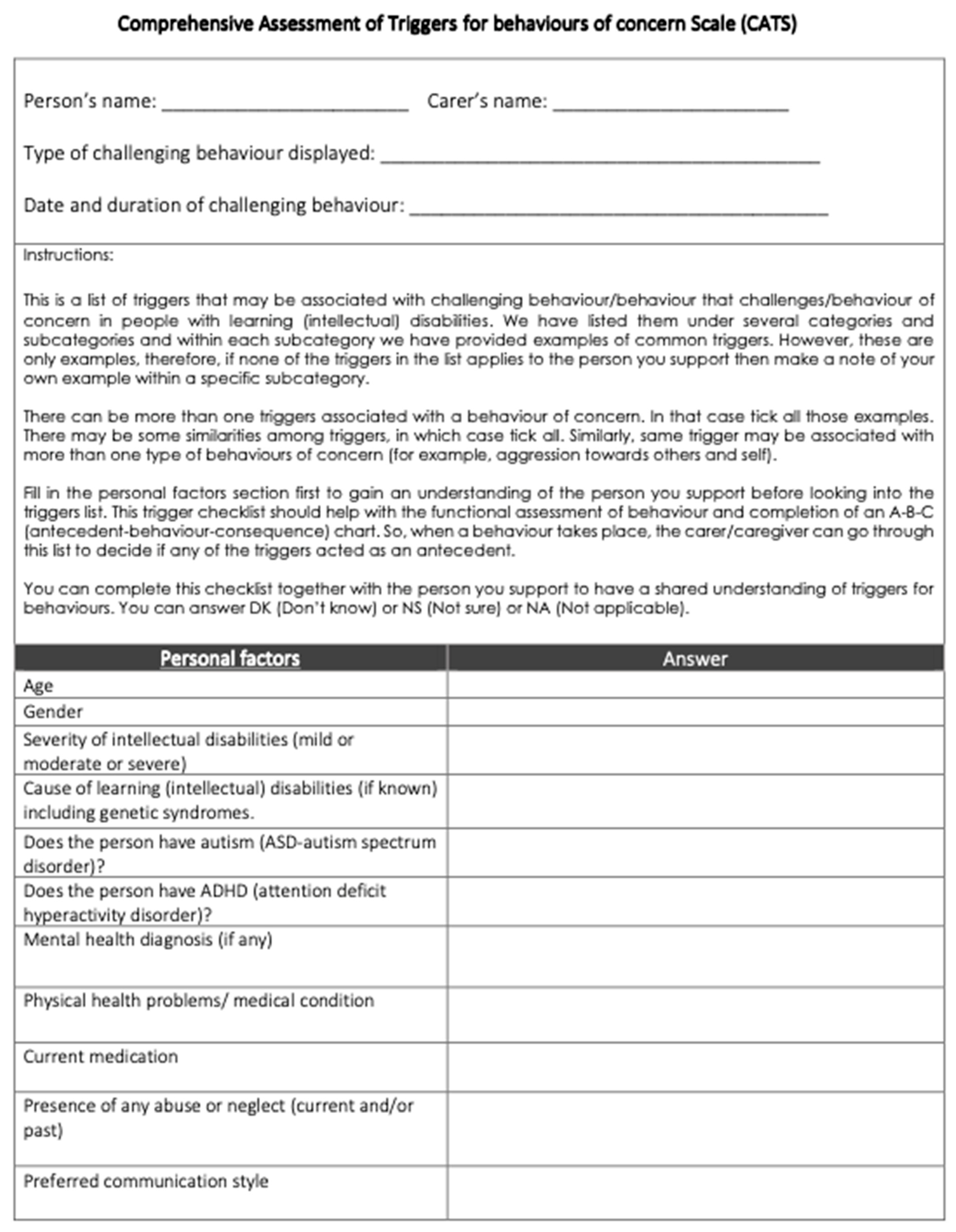

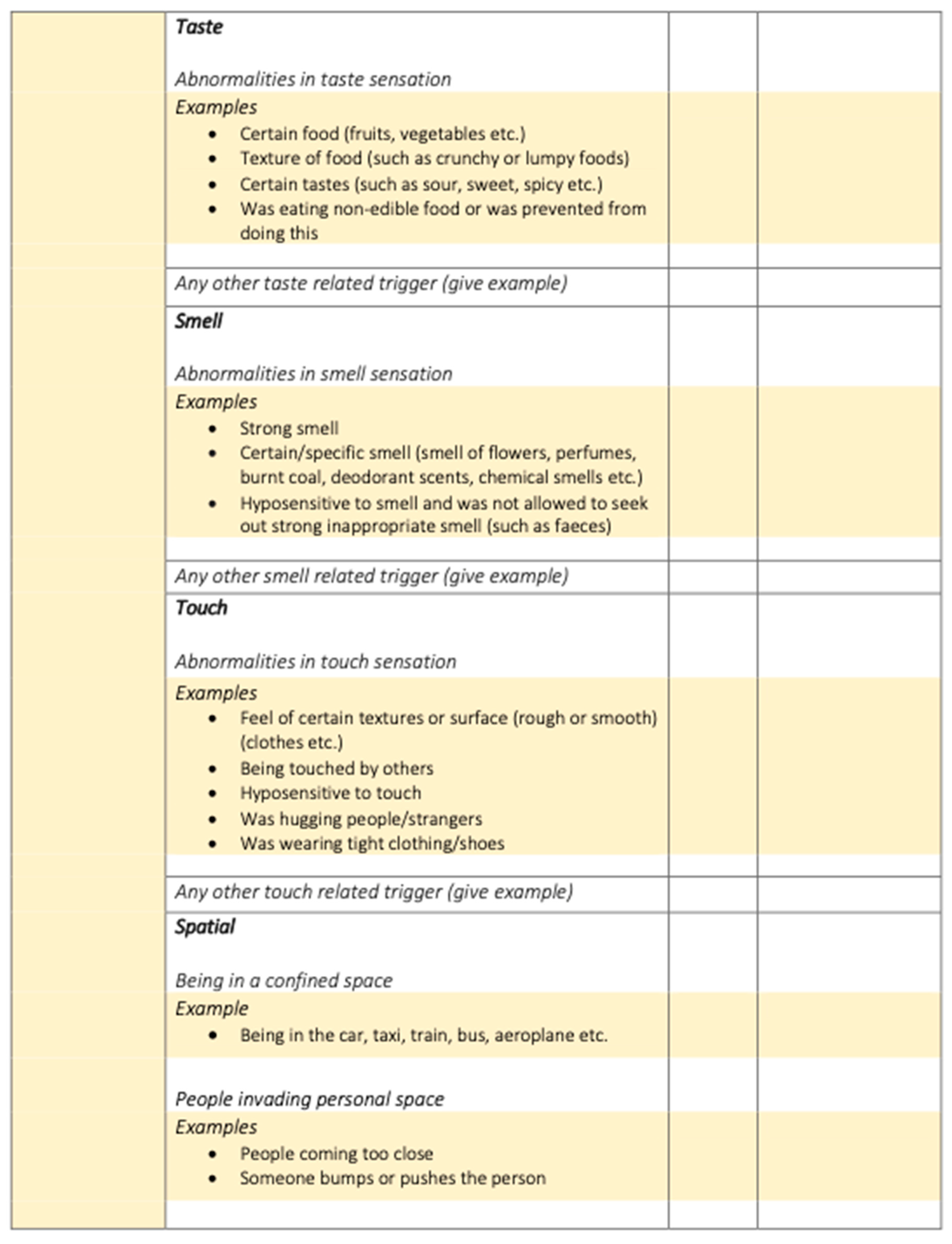
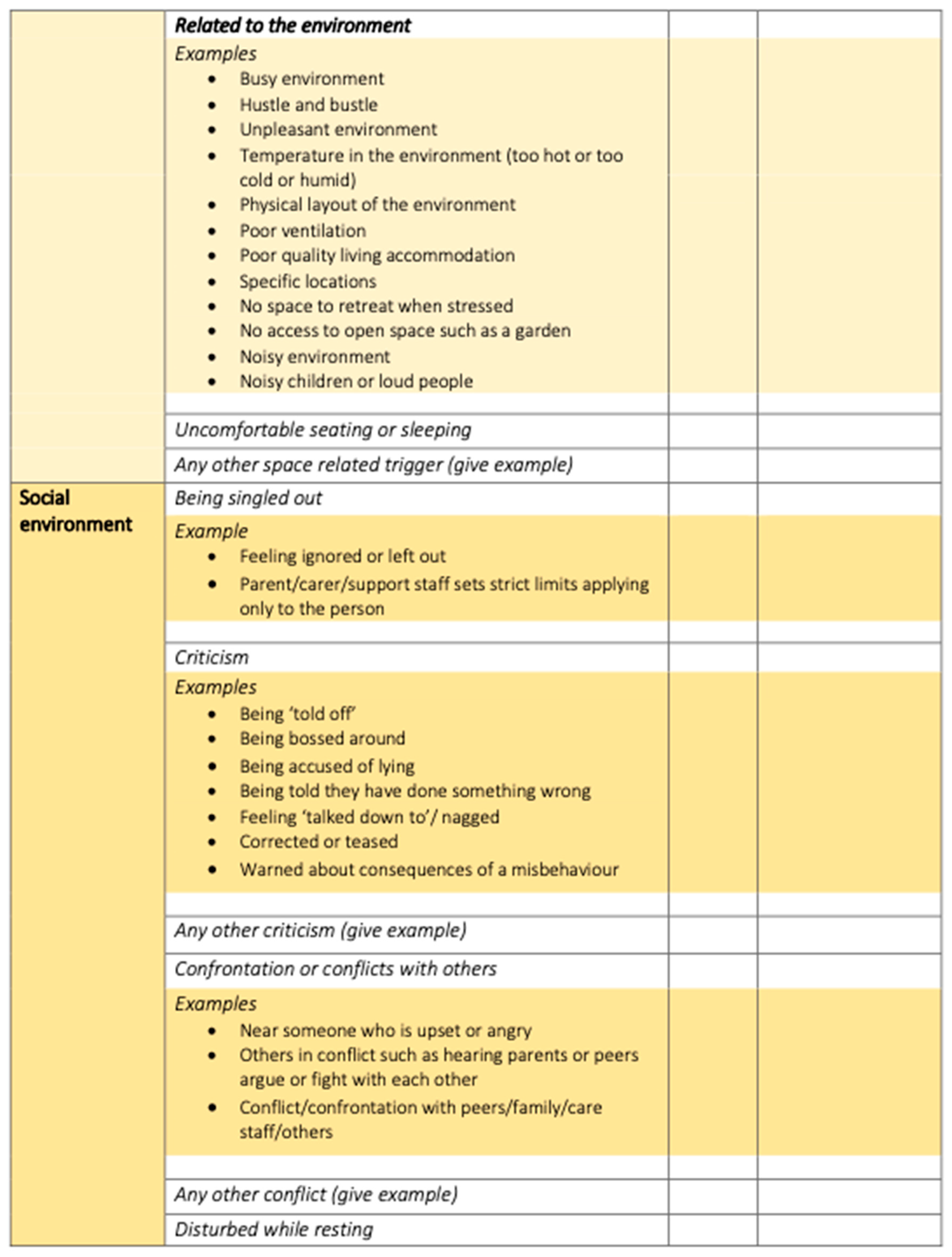
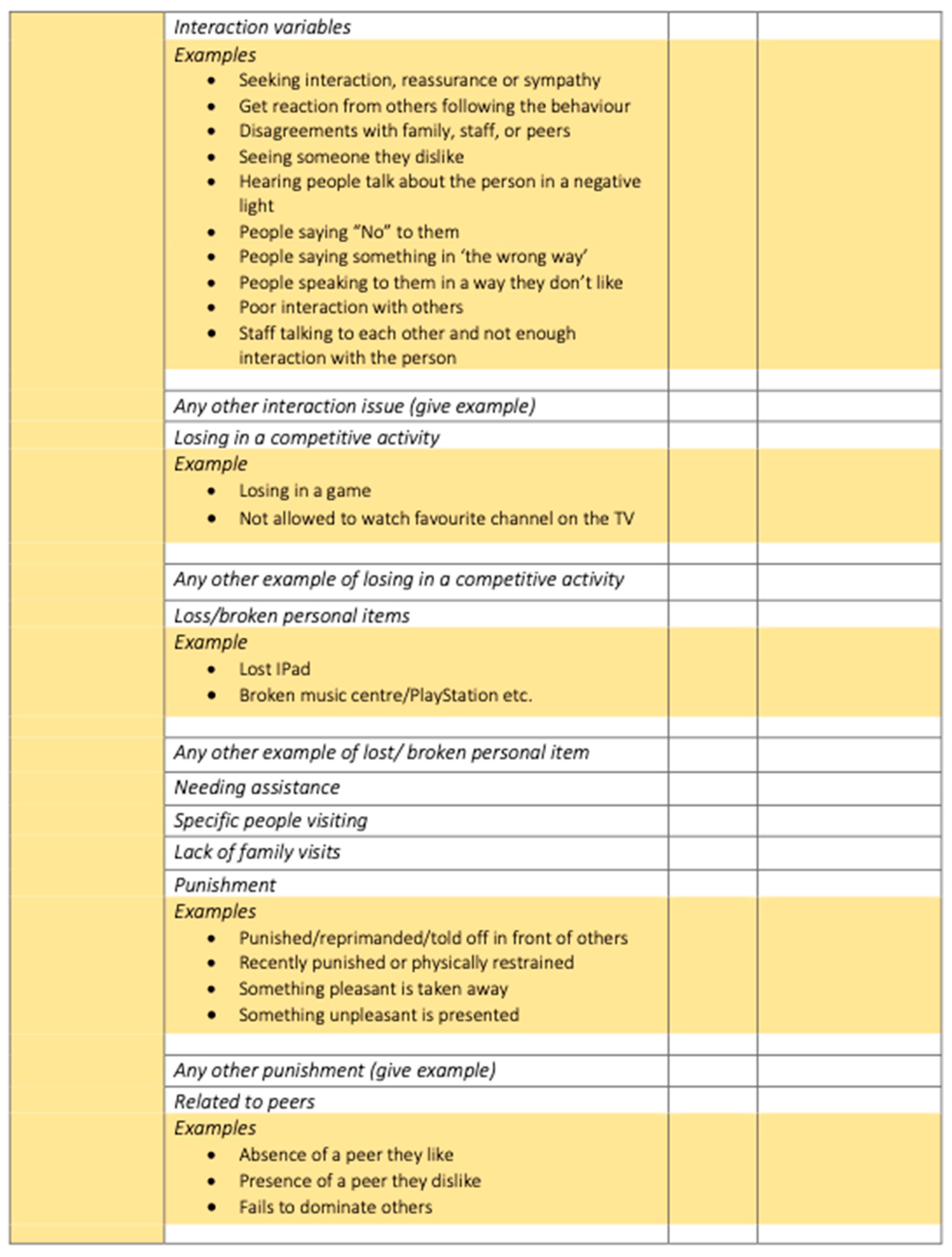
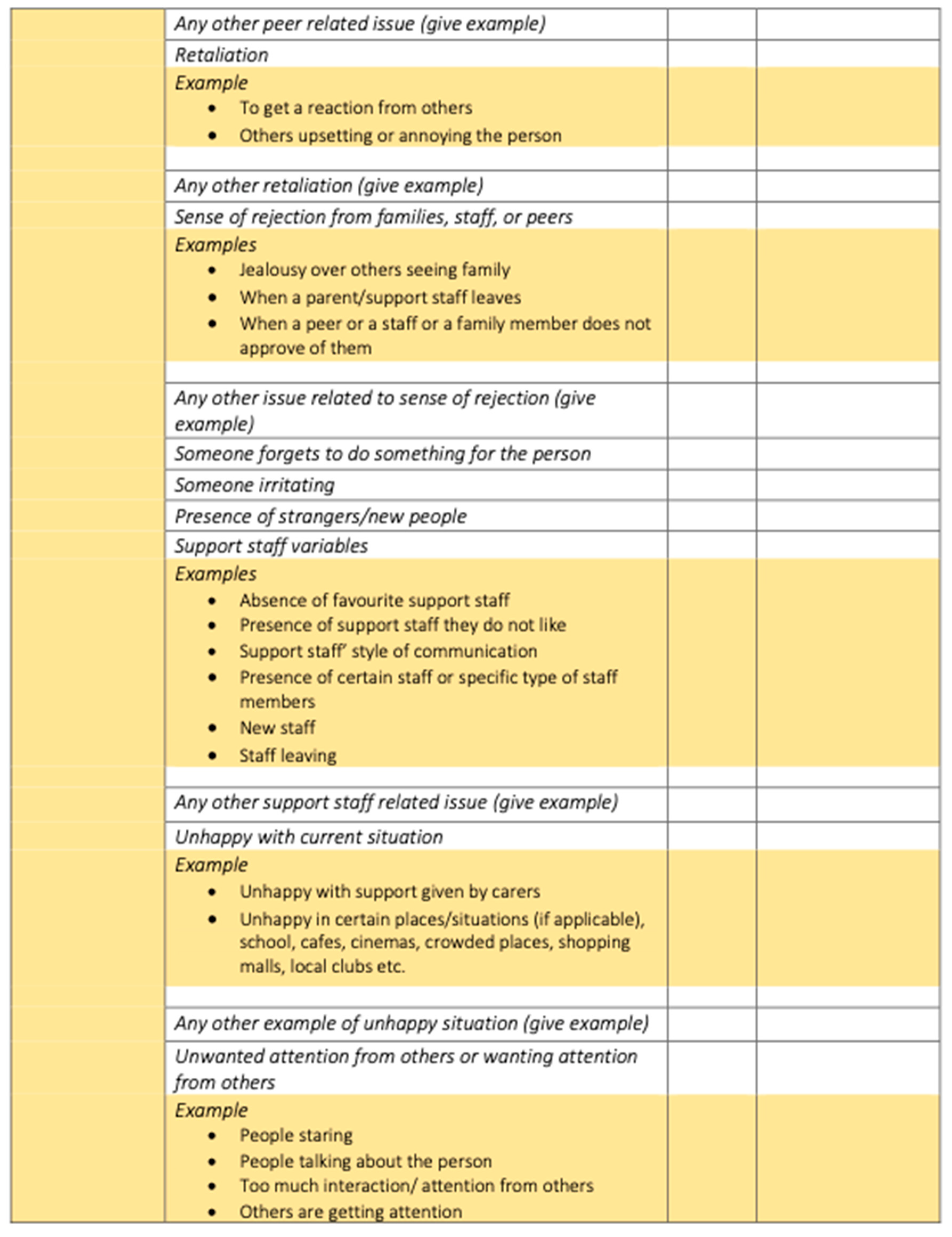
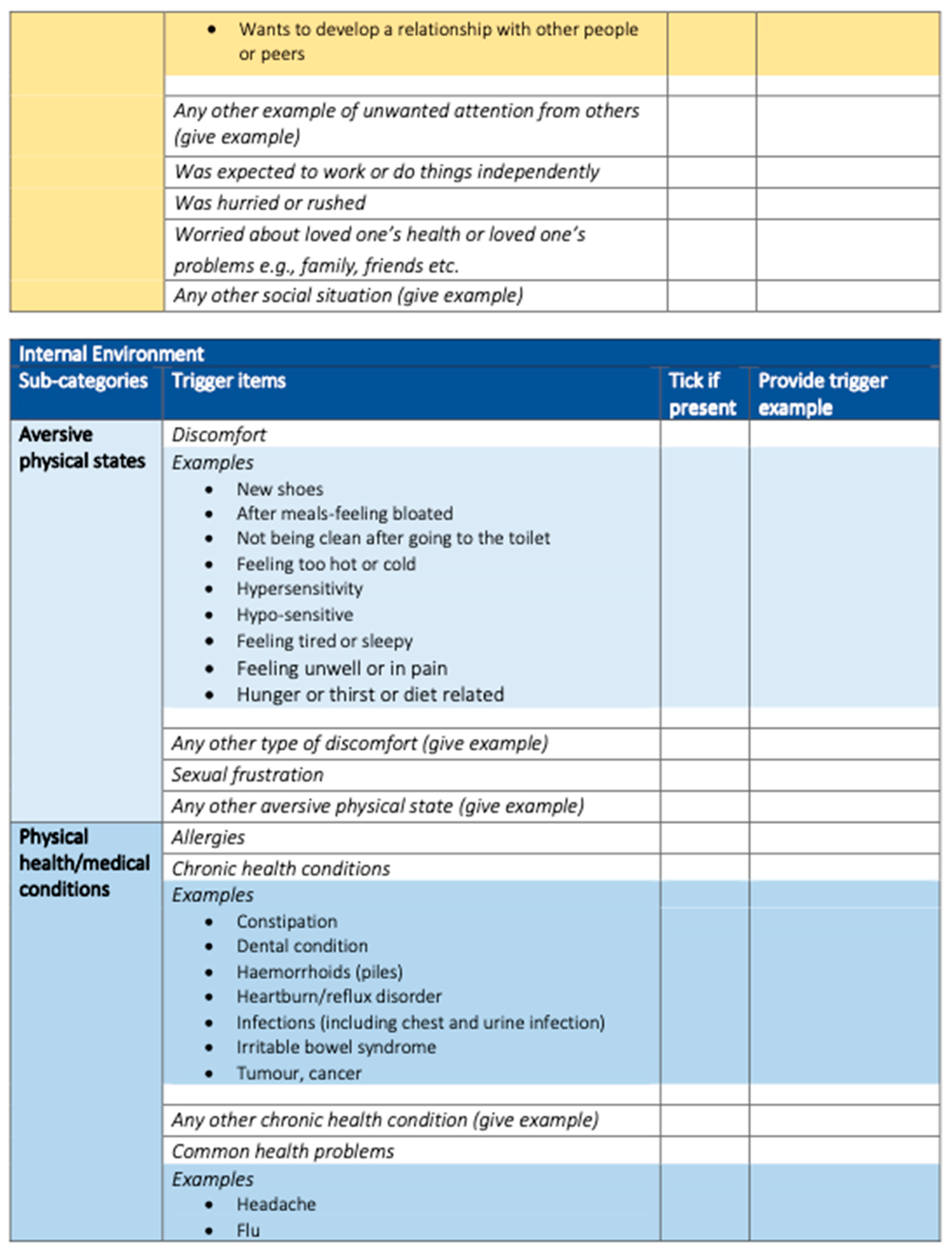


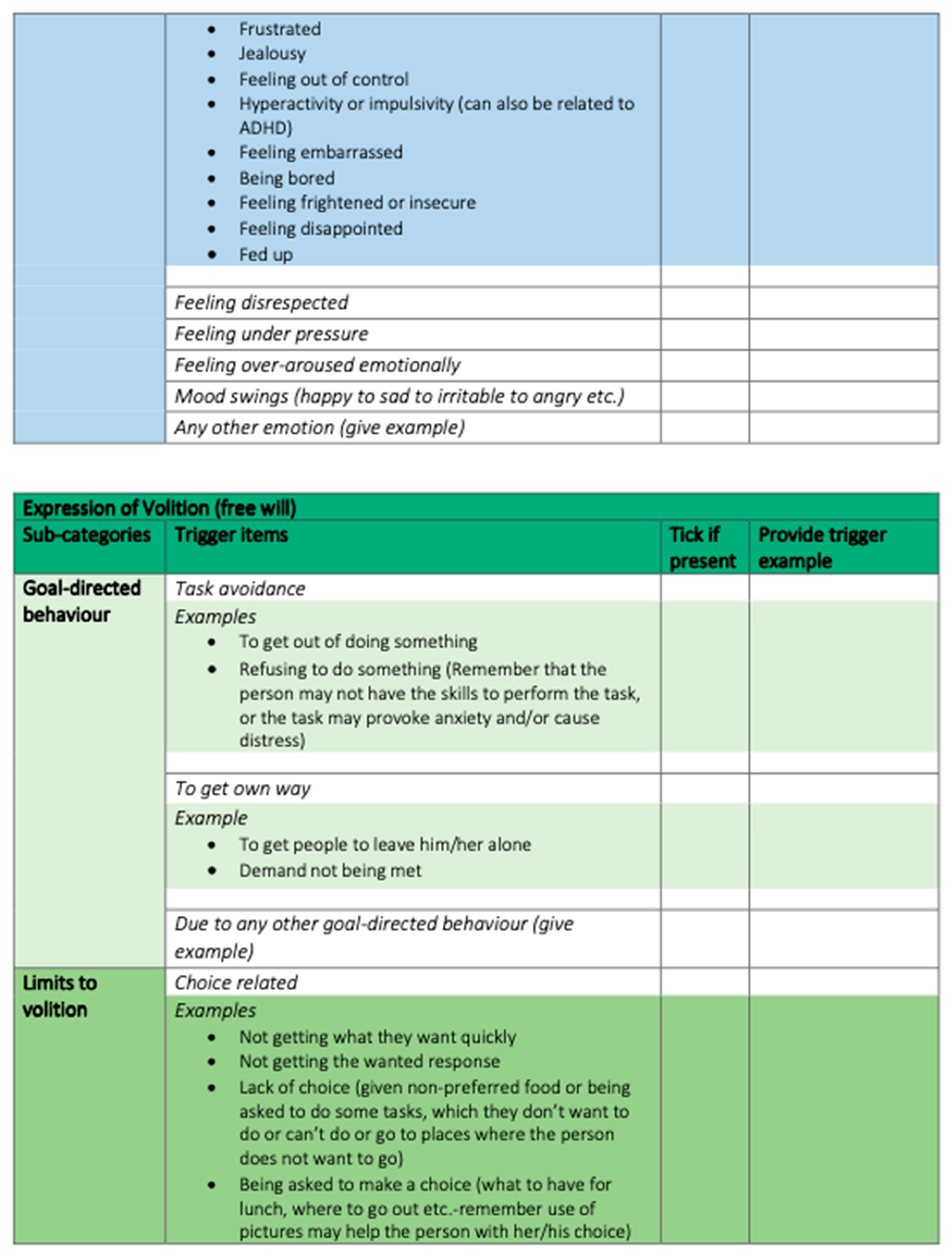
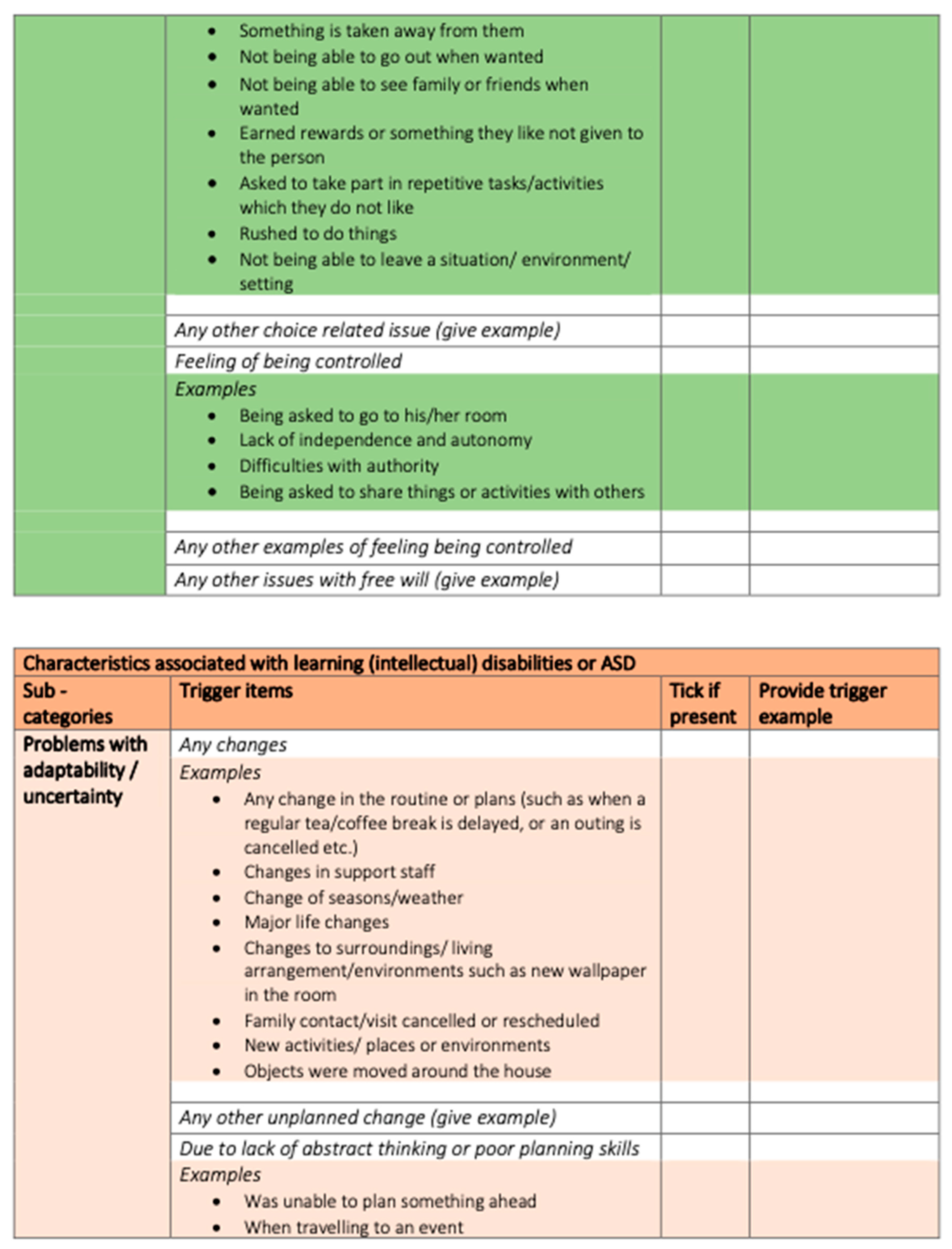



References
- Royal College of Psychiatrists; British Psychological Society; Royal College of Speech and Language Therapists. Challenging Behaviour: A Unified Approach. Available online: https://www.rcpsych.ac.uk/docs/default-source/improving-care/better-mh-policy/college-reports/college-report-cr144.pdf?sfvrsn=73e437e8_2 (accessed on 26 July 2021).
- Deb, S.; Thomas, M.; Bright, C. Mental disorder in adults with intellectual disability. 2: The rate of behaviour disorders among a community-based population aged between 16 and 64 years. J. Intellect. Disabil. Res. 2001, 45, 506–514. [Google Scholar] [CrossRef]
- Emerson, E.; Kiernan, C.; Alborz, A.; Reeves, D.; Mason, H.; Swarbrick, R.; Mason, L.; Hatton, C. The prevalence of challenging behaviors: A total population study. Res. Dev. Disabil. 2001, 22, 77–93. [Google Scholar] [CrossRef]
- Poppes, P.; Van Der Putten, A.J.J.; Vlaskamp, C. Frequency and severity of challenging behaviour in people with profound intellectual and multiple disabilities. Res. Dev. Disabil. 2010, 31, 1269–1275. [Google Scholar] [CrossRef]
- National Collaborating Centre for Mental Health. Challenging Behaviour and Learning Disabilities: Prevention and Interventions for People with Learning Disabilities Whose Behaviour Challenges NICE Guideline 11 Methods, Evidence and Recommendations Challenging Behaviour and Learning Disabilities Contents; National Collaborating Centre for Mental Health: London, UK, 2015. [Google Scholar]
- Knapp, M.; Comas-Herrera, A.; Astin, J.; Beecham, J.; Pendaries, C. Intellectual disability, challenging behaviour and cost in care accommodation: What are the links? Health Soc. Care Community 2005, 13, 297–306. [Google Scholar] [CrossRef]
- Chung, M.C.; Harding, C. Investigating Burnout and Psychological Well-Being of Staff Working with People with Intellectual Disabilities and Challenging Behaviour: The Role of Personality. J. Appl. Res. Intellect. Disabil. 2009, 22, 549–560. [Google Scholar] [CrossRef]
- Smyth, E.; Healy, O.; Lydon, S. An analysis of stress, burnout, and work commitment among disability support staff in the UK. Res. Dev. Disabil. 2015, 47, 297–305. [Google Scholar] [CrossRef] [PubMed]
- Matson, J.L.; Kozlowski, A.M.; Worley, J.A.; Shoemaker, M.E.; Sipes, M.; Horovitz, M. What is the evidence for environmental causes of challenging behaviors in persons with intellectual disabilities and autism spectrum disorders? Res. Dev. Disabil. 2011, 32, 693–698. [Google Scholar] [CrossRef] [PubMed]
- Lloyd, B.P.; Kennedy, C.H. Assessment and Treatment of Challenging Behaviour for Individuals with Intellectual Disability: A Research Review. J. Appl. Res. Intellect. Disabil. 2014, 27, 187–199. [Google Scholar] [CrossRef]
- Matson, J.L.; Vollmer, T.R. User’s Guide: Questions about Behavioral Function (QABF); Scientific Publishers: Baton Rouge, LA, USA, 1995. [Google Scholar]
- McGill, P. Establishing operations: Implications for the assessment, treatment, and prevention of problem behavior. J. Appl. Behav. Anal. 1999, 32, 393–418. [Google Scholar] [CrossRef]
- McAtee, M.; Carr, E.G.; Schulte, C. A Contextual Assessment Inventory for Problem Behavior. J. Posit. Behav. Interv. 2004, 6, 148–165. [Google Scholar] [CrossRef]
- McAtee, M.L. The Development of a Contextual Assessment for Problem Behaviour. Ph.D. Thesis, The State University of New York at Stony Brook, New York, NY, USA, 2002. [Google Scholar]
- Tustin, R.D.; Bond, M.J.; Forsaith, P. Antecedents of problem behaviour of people with intellectual disability. Behav. Chang. 1997, 14, 155–165. [Google Scholar] [CrossRef]
- Gardner, W.I.; Cole, C.L.; Davidson, D.P.; Karan, O.C. Reducing Aggression in Individuals with Developmental Disabilities: An Expanded Stimulus Control, Assessment, and Intervention Model. Educ. Train. Ment. Retard. 1986, 21, 3–12. [Google Scholar]
- McGill, P.; Teer, K.; Rye, L.; Hughes, D. Staff reports of setting events associated with challenging behavior. Behav. Modif. 2005, 29, 599–615. [Google Scholar] [CrossRef] [PubMed]
- Hastings, R.P. Measuring staff perceptions of challenging behaviour: The Challenging Behaviour Attributions Scale (CHABA). J. Intellect. Disabil. Res. 1997, 41, 495–501. [Google Scholar] [CrossRef] [PubMed]
- Deb, S.; Limbu, B.; Crawford, M.; Weaver, T. Short-term PsychoEducation for Carers To Reduce Over Medication of people with intellectual disabilities (SPECTROM): Study protocol. BMJ Open 2020, 10, e037912. [Google Scholar] [CrossRef]
- Carr, E.G.; Ladd, M.V.; Schulte, C.F. Validation of the Contextual Assessment Inventory for Problem Behavior. J. Posit. Behav. Interv. 2008, 10, 91–104. [Google Scholar] [CrossRef]
- Embregts, P.J.C.M.; Didden, R.; Huitink, C.; Schreuder, N. Contextual variables affecting aggressive behaviour in individuals with mild to borderline intellectual disabilities who live in a residential facility. J. Intellect. Disabil. Res. 2009, 53, 255–264. [Google Scholar] [CrossRef]
- Medeiros, K.; Rojahn, J.; Moore, L.L.; Van Ingen, D.J. Functional properties of behaviour problems depending on level of intellectual disability. J. Intellect. Disabil. Res. 2014, 58, 151–161. [Google Scholar] [CrossRef] [PubMed]
- Watkins, N.; Rapp, J.T. The convergent validity of the Questions About Behavioral Function scale and functional analysis for problem behavior displayed by individuals with autism spectrum disorder. Res. Dev. Disabil. 2013, 34, 11–16. [Google Scholar] [CrossRef] [PubMed]
- Paclawskyj, T.R.; Matson, J.L.; Rush, K.S.; Smalls, Y.; Vollmer, T.R. Questions about behavioral function (QABF): A behavioral checklist for functional assessment of aberrant behavior. Res. Dev. Disabil. 2000, 21, 223–229. [Google Scholar] [CrossRef]
- Matson, J.L.; Tureck, K.; Rieske, R. The Questions About Behavioral Function (QABF): Current status as a method of functional assessment. Res. Dev. Disabil. 2012, 33, 630–634. [Google Scholar] [CrossRef] [PubMed]
- Singh, A.N.; Matson, J.L.; Mouttapa, M.; Pella, R.D.; Hill, B.D.; Thorson, R. A critical item analysis of the QABF: Development of a short form assessment instrument. Res. Dev. Disabil. 2009, 30, 782–792. [Google Scholar] [CrossRef] [PubMed][Green Version]
- Sturmey, P. The Functional Analysis Checklist: Inter-rater and Test–Retest Reliability. J. Appl. Res. Intellect. Disabil. 2001, 14, 141–146. [Google Scholar] [CrossRef]
- Iwata, B.A.; DeLeon, I.G.; Roscoe, E.M. Reliability and validity of the functional analysis screening tool. J. Appl. Behav. Anal. 2013, 46, 271–284. [Google Scholar] [CrossRef] [PubMed]
- Matson, J.L.; Kuhn, D.E.; Dixon, D.R.; Mayville, S.B.; Laud, R.B.; Cooper, C.L.; Malone, C.J.; Minshawi, N.F.; Singh, A.N.; Luke, M.A.; et al. The development and factor structure of the Functional Assessment for multiple causaliTy (FACT). Res. Dev. Disabil. 2003, 24, 485–495. [Google Scholar] [CrossRef]
- Delgado-Casas, C.; Navarro, J.I.; Garcia-Gonzalez-Gordon, R.; Marchena, E. Functional analysis of challenging behavior in people with severe intellectual disabilities. Psychol. Rep. 2014, 115, 655–669. [Google Scholar] [CrossRef] [PubMed]
- Durand, V.M.; Crimmins, D.B. Identifying the variables maintaining self-injurious behavior. J. Autism Dev. Disord. 1988, 4, 99–117. [Google Scholar] [CrossRef]
- Singh, N.N.; Donatelli, L.S.; Best, A.; Williams, D.E.; Barrera, F.J.; Lenz, M.W.; Landrum, T.J.; Ellis, C.R.; Moe, T.L. Factor structure of the Motivation Assessment Scale. J. Intellect. Disabil. Res. 1993, 37, 65–74. [Google Scholar] [CrossRef]
- Bihm, E.M.; Kienlen, T.L.; Ness, M.E.; Poindexter, A.R. Factor structure of the motivation assessment scale for persons with mental retardation. Psychol. Rep. 1991, 68, 1235–1238. [Google Scholar] [CrossRef]
- Hastings, R.P.; Reed, T.S.; Watts, M.J. Community staff causal attributions about challenging behaviours in people with intellectual disabilities. J. Appl. Res. Intellect. Disabil. 1997, 10, 238–249. [Google Scholar] [CrossRef]
- Braun, V.; Clarke, V. Using thematic analysis in psychology. Qual. Res. Psychol. 2006, 3, 77–101. [Google Scholar] [CrossRef]
- Unwin, G.L. A Longitudinal Observational Study of Aggressive Behaviour in Adults with Intellectual Disabilities. Ph.D. Thesis, University of Birmingham, Birmingham, UK, 2014. [Google Scholar]
- de Winter, C.F.; Jansen, A.A.C.; Evenhuis, H.M. Physical conditions and challenging behaviour in people with intellectual disability: A systematic review. J. Intellect. Disabil. 2011, 55, 675–698. [Google Scholar] [CrossRef] [PubMed]
- Dunn, K.; Rydzewska, E.; Fleming, M.; Cooper, S.-A. Prevalence of mental health conditions, sensory impairments and physical disability in people with co-occurring intellectual disabilities and autism compared with other people: A cross-sectional total population study in Scotland. BMJ Open 2020, 10, e035280. [Google Scholar] [CrossRef] [PubMed]
- Moss, S.; Emerson, E.; Kiernan, C.; Turner, S.; Hatton, C.; Alborz, A. Psychiatric symptoms in adults with learning disability and challenging behaviour. Br. J. Psychiatry 2000, 177, 452–456. [Google Scholar] [CrossRef]
- Rojahn, J.; Matson, J.L.; Naglieri, J.A.; Mayville, E. Relationships Between Psychiatric Conditions and Behavior Problems Among Adults with Mental Retardation. Am. J. Ment. Retard. 2004, 109, 21–33. [Google Scholar] [CrossRef]
- Tyrer, F.; McGrother, C.W.; Thorp, C.F.; Donaldson, M.; Bhaumik, S.; Watson, J.M.; Hollin, C. Physical aggression towards others in adults with learning disabilities: Prevalence and associated factors. J. Intellect. Disabil. Res. 2006, 50, 295–304. [Google Scholar] [CrossRef]
- Bowring, D.L.; Totsika, V.; Hastings, R.P.; Toogood, S.; Griffith, G.M. Challenging behaviours in adults with an intellectual disability: A total population study and exploration of risk indices. Br. J. Clin. Psychol. 2017, 56, 16–32. [Google Scholar] [CrossRef]
- McGill, P.; Bradshaw, J.; Smyth, G.; Hurman, M.; Roy, A. Capable environments. Tizard Learn. Disabil. Rev. 2020, 25, 109–116. [Google Scholar] [CrossRef]

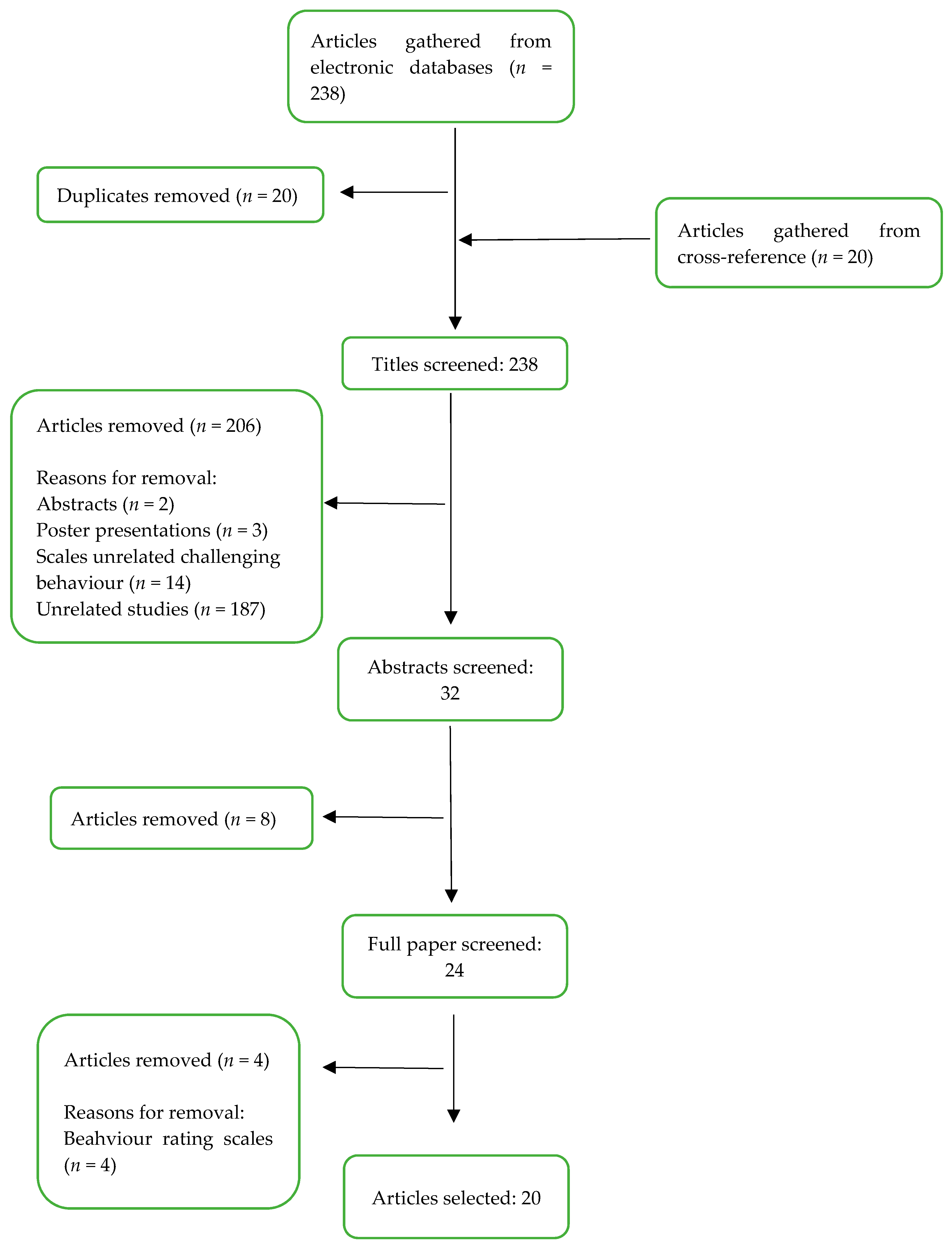
| Scale Name | Studies Identified by Literature Search in Relation to Scale | |
|---|---|---|
| Scales related to contextual variables | Contextual Assessment Inventory for Problem Behaviour (CAIPB) | McAtee (2002) [14] McAtee et al. (2004) [13] Carr et al. (2008) [20] Embregts et al. (2009) [21] |
| Setting Events List (SEL) | McGill et al. (2005) [17] | |
| Setting Events Checklist (SEC) | Gardner et al. (1986) [16] | |
| Setting Events Inventory (SEI) | Tustin et al. (1997) [15] | |
| Challenging Behaviour Attributions Scale (CHABA) | Hastings (1997) [18] | |
| Scales related to functional assessment | Questions about Behavioural Function (QABF) | Medeiros et al. (2013) [22] Watkins and Rapp (2013) [23] Paclawskyj et al. (2000) [24] Matson et al. (2012) [25] Singh et al. (2009) [26] |
| The Functional Analysis Checklist | Sturmey (2001) [27] | |
| Functional Analysis Screening tool (FAS) | Iwata et al. (2013) [28] | |
| Functional Assessment for Multiple Causality (FACT) | Matson et al. (2003) [29] | |
| Functional analysis | Delgado-Casas et al. (2014) [30] | |
| Motivation Assessment Scale (MAS) | Durand and Crimmins (1988) [31] Singh et al. (1993) [32] Bihm et al. (1991) [33] |
| Name of Scale | Items | Categories | Subcategories | Items per Sub/Category | Completion Method | Scale Development |
|---|---|---|---|---|---|---|
| Contextual Assessment Inventory of Problem Behaviour (CAIPB) [13] | 80 items with 13 open ended questions |
|
| Social/Cultural— Negative interactions: 22 items and 1 open-ended question; Disappointments: 10 items and 2 open-ended questions. Tasks/Activities— Factors related to tasks: 13 items and 1 open-ended question; Factors related to daily routines: 8 items and 2 open-ended questions. Physical— Uncomfortable environment: 6 items and 1 open-ended question; Changes in environment: 5 items and 2 open-ended questions. Biological Category Medication: 2 items and 1 open-ended question; Illness: 4 items and 1 open-ended question. Physiological states: 10 and 2 open-ended questions. | Likelihood of association between challenging behaviour (CB) and items are rated on a 5-point scale, from 1 (never) to 5 (always). | Scale development included 6 steps: review of the existing literature, generation of item pool, group items into the four generic categories, identify subcategories, determine format for measurement, administer inventory to staff, and evaluating the inventory. |
| Setting Event Checklist (SEC) [16] | 17 items | No categories | No subcategories | Not applicable | Occurrence/nonoccurrence of each item in the morning (a.m.) or evening (p.m.) recorded prior to attending programmes. | Developed by discussing with residential staff regarding situations or events that would provoke CB for a group of individuals with moderate and severe intellectual disabilities who lived in the residential facility and presented chronic CB while attending a community work training program. |
| Setting Event List (SEL) [17] | 76 items |
| No subcategories |
| Report whether target CB was more or less likely (or ’makes no difference’ or ’not applicable‘) across the items. | Developed in reference to 22 individuals with intellectual disabilities in 18 different residential service settings. |
| Setting Events Inventory (SEI) [15] | 155 items |
| No subcategories |
| Rate the likelihood of challenging behaviour occurring within 5 min of the client encountering each situation using a four-point scale: 0 (unlikely or occurs on less than 10% of occasions), 1 (sometimes or between 11% and 50% of occasions), 2 (often or from 51% to 80% of occasions), and 3 (almost always or over 81% of occasions). | Developed based on available literature and on information about individual clients that had been gathered using antecedent–behaviour–consequence (ABC) charts by the researcher. |
| Challenging Behaviour Attributions Scale (CHABA) [18] | 33 items |
| No subcategories |
| Five-point scale ranging from ‘very unlikely’ to ‘very likely.’ | Further developed from a 25-item scale previously developed by Hastings et al. (1997) [34] in which the items were collated from literature review and followed by ratings on the items by support staff based on case vignettes. |
| Theme/ Subtheme | Number of Carers Mentioning Theme (n = 100) |
|---|---|
| External Environment | 92 |
| Physical Environment | 54 |
| Social Environment | 75 |
| Internal Environment | 76 |
| Aversive Physical States | 22 |
| Medical Conditions | 28 |
| Mental Health Problems | 15 |
| Emotional States | 58 |
| Expression of Volition | 65 |
| Goal-Directed Behaviour | 8 |
| Limits To Volition | 63 |
| Characteristics of ID | 57 |
| Problems With Adaptability/Uncertainly | 54 |
| Communication Difficulties | 16 |
| Specific Activities/Events | 26 |
| Specific Activities | 16 |
| Specific Events | 13 |
Publisher’s Note: MDPI stays neutral with regard to jurisdictional claims in published maps and institutional affiliations. |
© 2021 by the authors. Licensee MDPI, Basel, Switzerland. This article is an open access article distributed under the terms and conditions of the Creative Commons Attribution (CC BY) license (https://creativecommons.org/licenses/by/4.0/).
Share and Cite
Limbu, B.; Unwin, G.; Deb, S. Comprehensive Assessment of Triggers for Behaviours of Concern Scale (CATS): Initial Development. Int. J. Environ. Res. Public Health 2021, 18, 10674. https://doi.org/10.3390/ijerph182010674
Limbu B, Unwin G, Deb S. Comprehensive Assessment of Triggers for Behaviours of Concern Scale (CATS): Initial Development. International Journal of Environmental Research and Public Health. 2021; 18(20):10674. https://doi.org/10.3390/ijerph182010674
Chicago/Turabian StyleLimbu, Bharati, Gemma Unwin, and Shoumitro (Shoumi) Deb. 2021. "Comprehensive Assessment of Triggers for Behaviours of Concern Scale (CATS): Initial Development" International Journal of Environmental Research and Public Health 18, no. 20: 10674. https://doi.org/10.3390/ijerph182010674
APA StyleLimbu, B., Unwin, G., & Deb, S. (2021). Comprehensive Assessment of Triggers for Behaviours of Concern Scale (CATS): Initial Development. International Journal of Environmental Research and Public Health, 18(20), 10674. https://doi.org/10.3390/ijerph182010674





